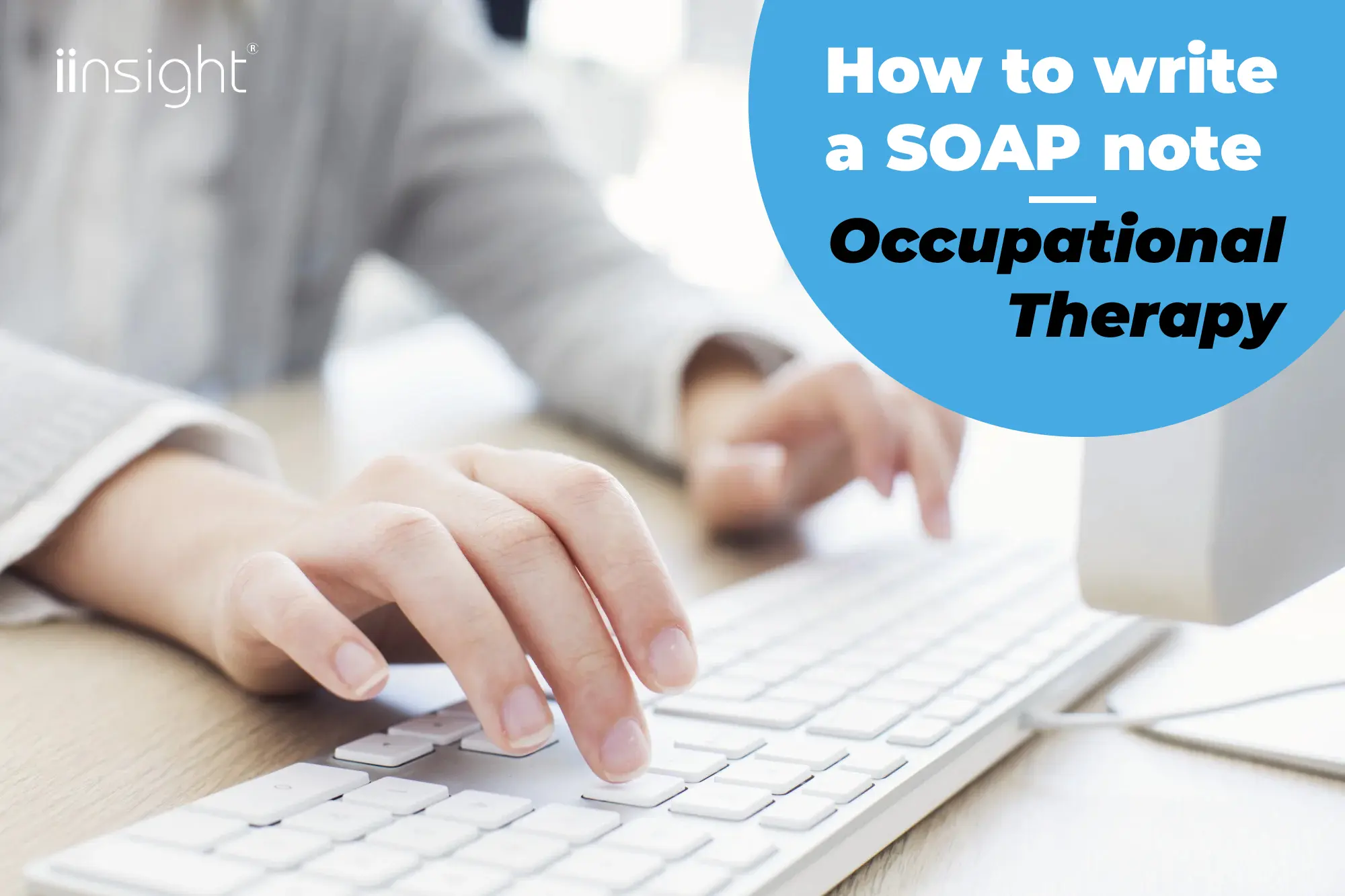How to Write a SOAP Note in Occupational Therapy
By Renato Parletta
- October 9, 2023
Table of Contents

SOAP notes are an integral part of the world of occupational therapy. They serve as the bridge that connects clinical assessment to effective treatment plans. As occupational therapists, your mission revolves around helping individuals achieve their highest level of independence and functional capacity.
To accomplish this, you need meticulous documentation that captures the essence of your patients’ conditions and guides therapeutic interventions.
This article is your comprehensive guide on how to write a SOAP note and it aims to demystify the art and science behind creating these essential documents.
Let’s explore the vital role of SOAP notes and how they contribute to enhancing the lives of those we serve.

Understanding SOAP Notes
In the world of healthcare, SOAP notes serve as a fundamental tool for documenting patient information and guiding clinical decision-making. These notes play a pivotal role in the practice of occupational therapy, offering a structured framework for gathering and organising critical data.
SOAP, which stands for Subjective, Objective, Assessment, and Plan, represents a standardised method for recording patient encounters.
It allows healthcare professionals to comprehensively document essential aspects of each interaction.
Subjective (S)
This is where therapists capture the patient’s perspective. It encompasses the patient’s symptoms, complaints, feelings, and observations shared by them or their caregivers.
This narrative aspect provides valuable context to the patient’s condition. It’s important to listen to everything the patient has to say, even if you’re not sure what the relevance is.
Objective (O)
Transitioning from the subjective realm to objective facts, the objective aspect emphasises measurable and observable data. It includes test results, vital signs, and the therapist’s own observations.
The objective section offers an unbiased foundation for assessments and plans.
Assessment (A)
This phase is where the therapist’s expertise and clinical judgment shine. After gathering subjective and objective data, the therapist analyses it to form an assessment.
This is where diagnoses, prognoses, and therapeutic goals are often defined.
Plan (P)
The plan section outlines the roadmap for treatment. It details the specific interventions, therapies, and strategies that will be employed to address the patient’s needs.
It represents the actionable part of the SOAP note, guiding the therapist’s next steps.
Significance of SOAP Notes in Occupational Therapy
Accurate and well-structured SOAP notes hold profound significance in the practice of occupational therapy for several reasons.
Firstly, they ensure continuity of care by serving as a means of communication among healthcare providers. As therapists change or when multiple therapists collaborate in a patient’s care, SOAP notes help maintain consistency and clarity regarding the patient’s condition and treatment plan.
SOAP notes also support evidence-based practice. By documenting the rationale behind treatment decisions and interventions, they empower therapists and other healthcare professionals to make informed choices, grounded in clinical data.
How to Write a SOAP Note: Writing the Subjective Section
The Subjective section of a SOAP note is a vital component that captures the patient’s perspective and provides essential context for their healthcare journey.
It delves into the patient’s narrative, offering insights into their condition, symptoms, and experiences.
Chief Complaint
This is where the patient’s primary reason for the visit or their main concern is recorded. It sets the stage for the entire assessment.
History of Present Illness (HPI)
The HPI offers a comprehensive description of the current problem. It includes details about when the issue began, how long it has persisted, its severity, and any factors that exacerbate or alleviate it.
Past Medical History
Information about the patient’s previous medical conditions, surgeries, medications, allergies, and relevant family medical history is included here.
Medications and Treatment
A list of the patient’s current medications, therapies, or treatments is documented to provide insight into their ongoing healthcare regimen.
Social and Lifestyle Factors
This section covers the patient’s living situation, occupation, hobbies, and any factors in their daily life that may influence their condition, such as smoking or alcohol use.
Writing the Objective Section
The Objective section of a SOAP note is a cornerstone of clinical documentation, providing an objective and measurable account of the patient’s condition. In this section, healthcare professionals record data gathered through clinical assessments, tests, and direct observations.
Physical Examinations
Begin by conducting thorough physical examinations relevant to the patient’s condition. Document findings such as vital signs (e.g., blood pressure, heart rate), range of motion, strength, sensation, and any physical abnormalities.
Diagnostic Tests
If applicable, include results from diagnostic tests, such as X-rays, MRIs, blood tests, or electrocardiograms. Report specific values and interpretations accurately.
Functional Assessments
Document the patient’s functional abilities, including activities of daily living (ADLs), mobility, and any limitations. Use standardised assessment tools when applicable, and report scores or outcomes.
Observations
Record objective observations made during the patient encounter. This may include observations of posture, gait, facial expressions, and any signs of discomfort or pain.
Progress Tracking
If this is a follow-up visit, compare current objective measurements with previous records to track progress or changes in the patient’s condition.
Writing the Assessment Section
The Assessment section in a SOAP note is where healthcare professionals provide their clinical judgment and analysis of the patient’s condition based on the information gathered in the previous sections.
This section is of paramount importance in clinical decision-making and treatment planning.
Clinical Decision-Making
This section allows healthcare professionals to consolidate subjective and objective data, applying their expertise to form a diagnosis or a working hypothesis regarding the patient’s condition. It is the phase where critical decisions about treatment and intervention are made.
Communication
The Assessment section serves as a concise summary of the patient’s status and progress. It enables effective communication among members of the healthcare team, ensuring that everyone is on the same page regarding the patient’s clinical picture.
Legal and Ethical Documentation
A well-documented Assessment section provides legal and ethical protection by demonstrating that clinical judgments and decisions were based on a thorough analysis of the patient’s information.
Writing the Plan Section
The Plan section of a SOAP note is where healthcare professionals outline the future course of action and treatment steps for the patient. This section plays a pivotal role in guiding patient-centred care and ensuring that healthcare goals are met effectively.
The Plan section serves as a roadmap for the patient’s ongoing care. It translates the assessment findings into actionable steps and provides a clear path toward achieving the patient’s health and functional goals.
Its primary functions are below.
Treatment Planning
The Plan section lays out the specific interventions, therapies, and strategies that will be implemented to address the patient’s needs. It outlines how the healthcare provider intends to manage the patient’s condition.
Patient-Centered Care
It emphasises patient-centred care by tailoring the plan to the individual patient’s goals and preferences. This ensures that the patient is an active participant in their own healthcare journey.
Communication
The Plan section serves as a communication tool, allowing healthcare providers to convey their intended course of action to other members of the healthcare team, ensuring consistency in care delivery.
Legal and Ethical Considerations
In the landscape of healthcare within the United Kingdom, adherence to rigorous legal and ethical standards is of paramount importance, particularly when it comes to SOAP note documentation.
Let’s look at the critical significance of compliance with these standards and underscore key considerations.
Patient Trust
Ethical and lawful practices are the bedrock of trust between healthcare providers and patients. Patients should have confidence that their personal information will be handled with the utmost professionalism and care.
Legal Obligations
Healthcare providers in the UK are legally obligated to protect patient information. Violations can lead to legal consequences, including fines and professional sanctions.
Quality of Care
Ethical and legal documentation practices contribute directly to the quality of patient care. Comprehensive and accurate SOAP notes support evidence-based decision-making, continuity of care, and better patient outcomes.
UK Regulatory Compliance
Complying with UK regulatory frameworks is imperative. Failing to adhere to these regulations can result in significant penalties and damage to a healthcare professional’s reputation.
In the UK, healthcare providers must adhere to regulations such as the Data Protection Act 2018 and the General Data Protection Regulation (GDPR). These laws stipulate strict guidelines for the handling and protection of patient data, emphasising the need for secure storage and controlled access.
Healthcare professionals should ensure that patient identifiers, such as names and addresses, are appropriately managed in SOAP notes. Electronic records must be stored securely, and access should be restricted to authorised personnel in compliance with UK regulations.
Book Your Demo With iinsight Today
Knowing how to write a SOAP note is the cornerstone of effective occupational therapy. At iinsight, we recognise the challenges therapists encounter in this process. That’s why we’ve developed a comprehensive all-in-one management system designed to streamline your workflow.
Our software simplifies case note and SOAP note creation, allowing you to provide exceptional care to your clients with ease. Ready to enhance your practice?
Click here to book a demo with our team and discover how iinsight can transform your occupational therapy documentation. Your clients deserve the best, and iinsight is here to support you every step of the way.
